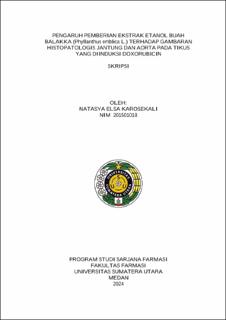| dc.description.abstract | Background: Doxorubicin (Dox) is a frequently used chemotherapy drug. However, the use of this drug in cancer therapy can cause toxicity. The main mechanism of dox toxicity is caused by the formation of Reactive Oxygen Species (ROS) which causes oxidative stress, thus spurring death. Balakka fruit has terapuetic efficacy in natural medicine system.
Objective: Analyzing EEBB at doses (100 mg/kgBB, 300 mg/kgBB, 500 mg/kgBB) can improve histopathological heart and aorta in Dox-induced rats.
Methods: The research stages include the preparation of EEBB by maceration method using ethanol solvent, characterization and phytochemical screening of simplisia, testing the cardioprotective effect, histopathological examination of heart and aorta organs in Dox-induced rats.
Results: Mean necrosis in the negative control was 1.00, while all doses of EEBB and positive control had no necrosis. Mean congestion in EEBB dose of 100 mg/kgBB and negative control was 1.00, EEBB dose of 300 mg/kgBB was 0.5±0.7071, and EEBB dose of 500 mg/kgBB and positive control had no congestion. Mean inflammation in the negative control was 0.5 ± 0.7071, while all doses of EEBB and positive control had no cardiac inflammation. Mean edema in EEBB doses of 100 mg/kgBB and 300 mg/kgBB, as well as negative control was 1.00, EEBB dose of 500 mg/kgBB was 0.5, while positive control had no edema. Mean foam cells in EEBB doses of 100 mg / kgBB amounted to 0.5 ± 0.7071, negative control amounted to 2.00 ± 4.00, while EEBB doses of 300 mg / kgBB and 500 mg / kgBB, as well as positive controls were not found foam cells.
Conclusion: EEBB (Phyllanthus embica L.) dose of 500 mg/kgBB has a cardioprotective effect that can improve the histopathological picture of the heart and aorta in Dox-induced rats. | en_US |


